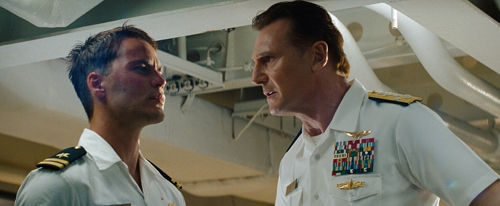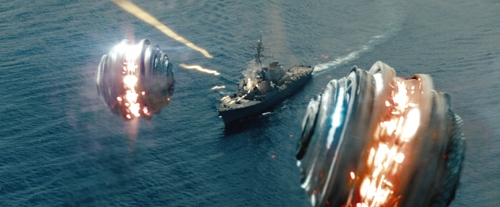
Rihanna is quite good in her big-screen debut.
Now that I have your attention, this article is actually about the extraterrestrial concepts which inform the big new movie Battleship. For those three people in Borneo who've missed the marketing onslaught, let me give you a quick primer.

Stuff blows up. A lot.
Battleship is based on the legendary Hasbro board game (indeed, targeting grids are played, and "peg"-like missiles imbed themselves in big grey navy boats). It's also the story of a youngish rapscallion (Taylor Kitsch, making Keanu look like Olivier) who joneses hard for a blonde hottie (Brooklyn Decker, blonde, hot). Seeking to impress her patriarchal Admiral dad (Liam Neeson, who could mumble the periodic table and I'd go twice), the husky-voiced ruffian takes charge of a besieged, very small fleet in Hawaii -- thus to combat extremely hostile space aliens with much larger and more devastating ships best described as giant rabid robotic leaping water panthers.
This is essentially a Michael Bay movie sans sillies (though directed by Peter Berg). Stuff blows up for two hours in so utterly rocking a manner that afterward you may have weird dreams about AC/DC being a primary component of volatile naval skirmishes. (And Rihanna, though limited to shouting one-liners -- "Mahalo, motherf-!" -- confidently presses those buttons to make things go boom.) Yet somehow, with Tom Morello's mega-guitar noodles atop everybody squinting and growling like Batman atop stunning ILM effects atop the loudest and most relentless movie explosions ever, this thing works. I was particularly impressed by the elder veterans and a disabled veteran (Gregory D. Gadson) striving on land and sea to combat their common alien foe -- even if the aliens do look and sound remarkably like Stone Temple Pilots in Iron Man suits.

Dr. Seth Shostak
It was this theme -- what do we really know about who's out there? -- which led me to Dr. Seth Shostak, a consultant on the movie whose day job as Senior Astronomer at the SETI Institute (Search for Extra-Terrestrial Intelligence) involves scanning space for signs and signals of anybody out there who might want to talk with us. Since those sorts of interviews could be a long way off, I spoke with the eminent and presumably human Dr. Shostak -- both before and after his screening of Battleship. He advocates all sorts of methods of searching, from optical and radio telescopes to training our focus on distant stars, lest alien construction fleets get busy around them. First I ask him where in the cosmos we'd be most likely to find intelligent alien life. "We don't know," he candidly replies. "Not yet.
"We do know now, it seems, according to results that have been published in the last month or so, that most stars have planets, but of course not all planets are suitable for life. A planet like Mercury, no matter how clever the aliens are, they're probably not going to eke out an existence on a planet like Mercury -- or for that matter, Neptune, or any of those. So we want to know how many of those planets are out there which are sort of like Earth, and where they are, and we're just beginning to learn that, thanks to the NASA Kepler telescope."

You should see the goatee.
We discuss a term used in Battleship -- "Goldilocks planet" -- where "the porridge is just right" for life. And this leads to the notion that if there were life out there, would it resemble Hollywood aliens, friend or foe?
"We tend to imagine them as being anthropomorphic, that they sort of look like us, because in the movies they usually do," muses Shostak. "They're humanoid, but something terrible has happened to them, if you will, and they've had parts of their bodies replaced with things that look a little odd to us. But of course Hollywood is somewhat compelled to do that, because if they looked like bicycles or something like that, you wouldn't know how to relate to them. So for storytelling reasons, they assume that they'll look something like us. And there are some scientists who agree."
Shostak names Simon Conway Morris, of Cambridge University, who believes the human form to be optimal for a thinking being. Noting that, unlike Morris, he's not an evolutionary biologist, Shostak nonetheless politely disagrees: "All you have to do is go to the zoo, and look at what's there. And those are all Earthlings, those are all things that share a lot of our DNA, the fish, the snakes, and all, and they don't look like us."
I ask about inorganic intelligence. Like, for instance, are there free-roaming clouds of intelligent electrons? "There are clouds of electrons floating around, plenty of 'em!" he assures me. "Even in the Earth's atmosphere. But they're not particularly clever, because to be clever requires a certain degree of organization, and clouds of electrons are not very well organized."

Rihanna. She's quite good.
Okay, this is a fun conversation. Shostak also probes the notion of intelligent clouds of gas, but leans toward the far likelier A.I., Artificial Intelligence. "We don't have that here on Earth yet, but there are plenty of people in plenty of places working on artificial intelligence, and while they haven't succeeded, they fully expect to succeed." He cheerfully continues with an eerie concept: "Now let's say that it takes another hundred years. Nobody knows, but you have to say that's really very interesting, because it means that from the point that we developed technology, within a few hundred years of that, we've invented thinking machines. And so if the aliens have done that too, then they've invented their own replacements, if you will. Or if not replacements, at least successors.
"So it could very well be -- and I think this is a very reasonable hypothesis -- that the majority of the intelligence in the cosmos is in fact not organic, it's artificial intelligence. Because once you invent that, then it can design its own successors, and do a much better job of it than we could. And beyond that, it's not stuck with Darwinian evolution anymore -- as we are. So it sounds to me like that's the way to go."

Potential father-in-law. Cool.
I turn us to the matter of Battleship's "Beacon project," which is the sort of thing against which Steven Hawking recently warned, i.e., deliberately transmitting messages into space, hoping to contact aliens. Shostak posits that the sort of alien this is likely to attract wouldn't be the cobbler who sits around back in Barcelona fixing shoes -- but rather the Conquistadors firmly bent on territorial conquest. "If aliens were to come to Earth," he suggests, "I would not be surprised if the ones you met would not be the friendly ones."
Hm. But have we sent such signals? He notes that as recently as 2008 (to celebrate their 50th birthday), NASA beamed the Beatles' "Across the Universe" out to Polaris, the North Star, 431 light years away. Do we expect anybody to sing along? "Who knows," laughs the astronomer, "maybe the aliens don't like the Beatles." Funny, as much as I love "Across the Universe," I'd say the aliens in Battleship would definitely lean Stones. Meanwhile, Dr. Shostak heads off to see the movie, and then our conversation resumes.
"It was pretty enjoyable, actually," he later opines. "You know, it's an action film, and it's not going to change my philosophy of life. But I have to say I enjoyed it." The scientist continues: "I'll be honest, when I saw the film tonight, it was the battle that interested me, more than the problem with the misbehaving young officer trying to date the Admiral's daughter. Those are stories we've seen many times. Whereas seeing the U.S. Navy take on the aliens, we've never seen that." As a veteran of digital animation himself (via DIGIMA, the company he founded in the Netherlands), he adds, "the visuals were pretty darned impressive."
We also discuss the diversity of the sailors. Shostak grew up in Arlington, Va., with the Pentagon a stone's throw away, amongst many government and military people. "There's a lot of variety in the characters being portrayed. And here we are at Pearl Harbor, and the Japanese are on our side. And you could say, 'Oh, isn't that trite, or clichéd?' -- but I'll tell you, the audience at this screening tonight, they cheered, not just at one spot in the film. They cheered and they applauded many times in the film." He notes, "My wife enjoyed the film, and she's not big on sci-fi."

When these things come at ya, turn.
Then we get down to the science of connecting with extraterrestrials. We have a few light laughs over highly serendipitous interstellar reception and radio waves made to look like bright blue triangulating laser beams, and Shostak gets frank: "I think it does handle a few things. Once again, it suggests that aliens could be anthropomorphic, they could look like us -- because these guys looked like guys out of a retirement home, with prickly goatees." The movie also closely paraphrases Hawking's warning: "Mind you, that has been debated in the SETI community, too: Is it safe to transmit? That's a legitimate issue, and it was certainly highlighted in the film."
Our discussion spans classic '50s sci-fi, the moon landings of the '60s and '70s, and the scuttling of manned Mars exploration in favor of "sending motorized skateboards to Mars." Shostak is an insightful fellow, and these topics prove bountiful, but we steer toward something more soulful: How does space exploration, and research in general, benefit our world which is already beset with so many problems?
"'Why are we spending money on this?' It seems so frivolous to some," explains Shostak. "So I have to answer that question fairly frequently. I think it is essential to do basic research -- you know, Europeans are spending five billion on finding the Higgs bozon; if you were to ask the next person you meet on the street what they think of the Higgs bozon, I'm sure it would be nothing.

I was going to make a Twister joke. But that's already a movie.
"It's because of curiosity. And curiosity sounds like something that's very superficial: 'We can't afford curiosity. We have to deal with real social problems, or war and peace, or the climate,' or whatever. But the facts are that curiosity is, in the end, what saves us, every time. Because basic research always pays off, and if you don't do that, if you don't have that curiosity, that dynamism, then you're going to be like ancient Egypt -- which was a very static society for three thousand years. And in the end it was very fragile and vulnerable. The Greeks took it over, and then the Romans, because it was a static society.
"Even the government has reckoned that for every dollar they spend on NASA, the civilian economy eventually gets ten dollars back. It sounds to me like if you want to stimulate the economy, just put the whole federal budget into NASA: 'Get ten dollars back for each dollar!'"
Beats funneling it all into war machines, I offer. Unless of course scenarios like that of Battleship come our way. (I'd take that risk.)
We close on a chuckle over something Shostak firmly does not do, which is to confirm U.F.O. encounters. Apparently a third of the population of the U.S. believe that we have been visited (which the good Doctor does not believe), so I ask why so many of these flying saucers tend to find their way to this country specifically.
"They usually come to the American Southwest, you see," laughs Dr. Seth. "They really like the Tex-Mex cuisine."
Battleship opens this Friday across America.
Battleship photos courtesy of Universal Pictures.